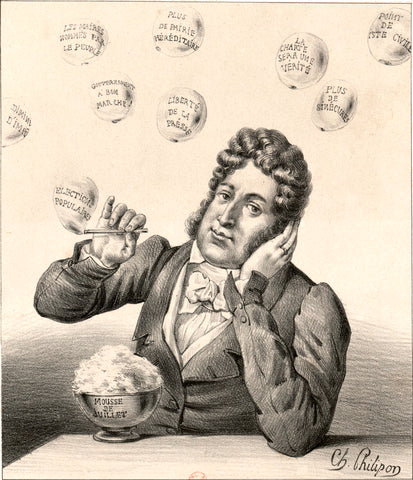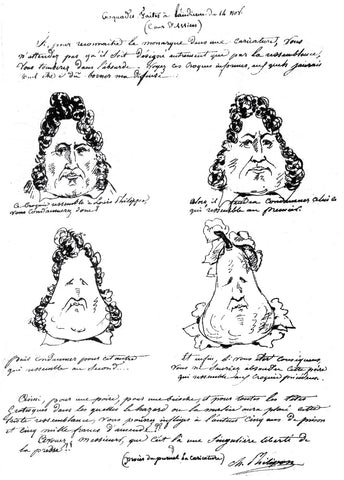- Continue Shopping
- Your cart is empty
Louis Philippe: This is not a Pear!
The story is one that goes down as maybe one of the greatest in French art history. Who knew that the drawing of a pear could land you in prison for fifteen months with an additional 10,000 franc fine on top of that! The date was November 14th, 1831. Charles Philipon, a lithographer, caricaturist, and journalist, then 29 years of age, ran a year-old weekly by the name of La Caricature.

Charles Philipon
The journal was notorious for its provocations, and by that November date, Philipon had been subject to eleven prosecutions. The royal government was cracking down on the press and Philipon had been taken to court in Paris for his “transgressions.” This time, his drawings were charged with "outrage against the person of the King." The reason for his trial was due to the fact that he had published a drawing in his weekly showing that the head of the king, Louis-Philippe, could be magically transformed into a pear in just four easy steps (the word for 'pear' – poire – was common slang for "dupe" in France at the time).

His choice of defense at his trial would be one that would become legend. Taking the stand, Philipon argued that maybe his cartoon DID look like the King. But what was the "resemblance"? Something that could never be the property of a "single man" he argued. Philipon then presented the court with a quick sketch he did of the same four drawings, the sequence again showing Louis-Philippe’s head morphing into a pear. There was no doubt that the sketches were held together by imperceptible links. The first did indeed look like Louis Philippe and the last resembled the first in a way, however, it was clearly a pear.

Philipon's Defence Sketches
Philipon then began to attack the terms of trial stating that if “resemblance” could be owned, then the system would lead the law into absurdity. Where would it end? He then declared that a king may only be recognized by his symbols, and since his portrait had no crown, or written title or name, then how would it be possible to say that this was a depiction of the “real” king? The royally backed court took little sympathy, and his newspaper was seized by the state. In prison, however, Philipon would notice that the walls of his cell were covered in pear graffiti. Similar caricatures would spring up all over Paris and France for the next decade. The unintended consequence of the affair would only popularize the image, especially among the illiterate. The artists that followed in Philipon’s footsteps (Daumier for example) would turn the pear into a hated image subject to the mercy of public rage and would further inflict a variety of symbolic tortures on the Louis-Philippe, depicting the pear hanged, drawn, and quartered, and much more.

When Philipon was later accused of inciting regicide due to a drawing of the pear on a pedestal on the site where Louis XVI was guillotined, he simply retorted that if anything, he could only be accused of inciting the public to “make some jam”!





Harrison Hunt
Author